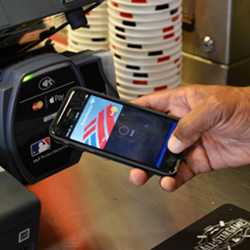
After successfully launching Apple Pay in 2014, Apple has set its sights on another segment of the payments ecosystem.
While Apple Pay allows consumers to make purchases at more than 700,000 retail outlets in the U.S. by simply tapping their iPhones on compatible payment terminals, Apple is staking its claim in the rapidly growing person-to-person (P2P) payments market, a segment that could see more than $11 billion in annual transactions by 2017.
Last July, Patently Apple uncovered a patent application from Apple detailing a method for conducting P2P payments. While the concept is not new, Apple’s take is unique and could help vault this method of payment into the mainstream. The patent application suggests payments can be authenticated using Apple’s Touch ID biometric technology, enabling iPhone users to easily transfer funds between each another.
Mobile person-to-person payments have experienced an uphill battle in consumer adoption. The U.S. Federal Reserve’s "Consumers and Mobile Financial Services Report," published in March 2015, found while mobile phone penetration is high — more than 87% of American adults own a cellular device — only 22% of mobile phone owners have made a payment using their devices.
Numerous P2P solutions are available, including clearXchange, a payment network owned by a consortium of America’s largest banks (and rumored to be a potential partner in Apple’s venture) and PayPal. Yet Federal Reserve data suggests less than 10% of mobile phone owners have made a mobile P2P payment.
Apple’s patent has quickly moved from the conceptual to a real-world application, as Apple is expected to launch a person-to-person payment platform in 2016. The Wall Street Journal reported Apple is in talks with several financial services companies — including clearXchange — and could soon roll out a product that will compete with established technologies, including PayPal and Square.
Kevin Krewell, principal analyst at Tirias Research, believes this is a significant step for Apple. "Apple’s move into the mobile P2P payment space is an extension of its B2C mobile payment strategy. The company is moving on all fronts as the mobile phone will eventually become our mobile wallet."
An Aite Group survey found cash is by far the preferred method of payment when people have to pay one another, with 71% of survey respondents preferring cash for P2P payments. There are plenty of non-cash alternatives currently available; PayPal is a top choice, with 49% of households using the service. Venmo (owned by PayPal), on the other hand, is much lower down on the list of preferred methods of payment. While wildly popular on college campuses for students paying one another for food, drink, and rent, Venmo was only used by 5% of households for P2P payments. Among students Venmo has become a verb ("I’ll Venmo you $10 for my share of the pizza"), but the service has yet to gain more mainstream adoption.
Square, which recently went public, has a smaller share of the P2P payments market, but is also building on a unique platform to grow payments. The company partnered with Snapchat last year on the introduction of Snapcash, which allows Snapchat users to send cash as easily as sending a text message.
Jonathan Ross, research director at Panoramic Research, says Square’s P2P offering, while strong, is no moneymaker. "Mobile P2P is growing, but most of the products in the marketplace are free and don’t add a revenue stream. I’m sure that an Apple P2P service will be great, but I don’t see people flocking to buy an iPhone just because they can send payments to their friends."
While companies may not make money from P2P transactions, there is still value in offering P2P to customers. Tirias Research’s Krewell says, "The addition of P2P transactions allow a new level of personal financial transactions to be performed with our phones, further increasing the utility of the phones." Venmo, Snapcash, PayPal and whatever solution Apple eventually launches will only serve to bring P2P to more people.
Apple’s conceptual product has a number of things going for it, but it is not necessarily the solution for everyone. More than half of U.S. smartphone owners (51.4% as of July 2015) actually have an Android device, which essentially eliminates half of the population from accepting P2P payments that rely on the Apple operating system and devices.
An advantage P2P platforms like Venmo have is that they are device-agnostic. The Venmo app is available on iOS and Android devices, so consumers more easily make P2P payments with it, regardless of the device they own. Apple will likely limit who can receive payments, based on the device they have. "While I’d like to see Android and iOS interoperability on financial transactions, that’s going to take longer to achieve," says Krewell.
Mark Broderick is a Tampa, FL-based senior research analyst covering the financial services and payments industries for ORC International.



Join the Discussion (0)
Become a Member or Sign In to Post a Comment